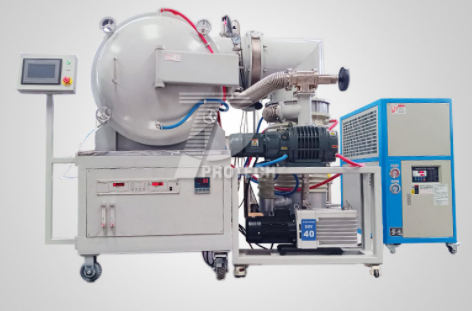

EXPLORE THE NEW TRENDS AND ADVANCED TECHNOLOGIES IN THE HEAT TREATMENT EQUIPMENT INDUSTRY
Ask for a free consultation Ask for technical support

Tel

WhatsApp/WeChat
Contact Us
All products are customizable, leave message immediately, we will reply as soon as possible.
Vacuum heat treatment furnaces are very useful in materials laboratories. They can provide high-temperature, oxygen free, or low oxygen heat treatment environments, suitable for heat treatment and surface treatment of various materials, such as sintering, brazing, annealing, normalizing, tempering, etc.

Commonly used vacuum heat treatment furnaces(Click on the image to view product details)
1. A laboratory vacuum furnace typically consists of the following main components:
① Furnace body: The furnace body is the main part of a vacuum furnace, used to accommodate samples or workpieces to be processed. The furnace body is usually made of high-temperature materials, such as stainless steel, graphite, etc., to withstand the heat treatment process in high-temperature environments.
② Heating element: The heating element is responsible for providing heat energy to raise the temperature inside the furnace to the required heat treatment temperature. Common heating elements include resistance wires, graphite, molybdenum strips, etc., which can be installed inside or outside the furnace body as needed.
③ Vacuum system: The vacuum system is responsible for extracting air from the furnace, creating an anaerobic or low oxygen heat treatment environment. Vacuum systems typically consist of vacuum pumps, valves, pipelines, etc. Valves are used to control the entry and exit of gases, including suction valves, inflation valves, and safety valves. The vacuum degree inside the furnace can be controlled by adjusting system parameters.
④ Gas inlet and outlet: Gas inlet and outlet are used to introduce or discharge inert gases or process gases into the furnace, such as nitrogen, argon, etc. To regulate the atmosphere composition during the heat treatment process. These imports and exports are usually equipped with valves and flow control devices to accurately control gas flow and composition.
⑤ Temperature control system: The temperature control system mainly includes temperature sensors (such as thermocouples), controllers, and heating power adjustment devices, which are used to monitor and adjust the temperature inside the furnace, ensuring the stability and accuracy of temperature during the heat treatment process.
⑥ Security system: The security system is used to monitor the temperature, pressure and other parameters inside and outside the furnace, and take corresponding protective measures in case of abnormal situations, such as overheating protection, overvoltage protection, emergency stop button, etc., to ensure the safety of operators and equipment.

Vertical graphite vacuum heat treatment furnace(Click on the image to view product details)
2. The main characteristics and applications of vacuum heat treatment furnaces:
① High temperature environment control: The vacuum heat treatment furnace can perform heat treatment in a high temperature environment, with a commonly used temperature range of 500-2100 ℃. This high temperature environment can be used for annealing, sintering, heat treatment and other processes.
② Oxygen free or low oxygen environment: Vacuum heat treatment furnaces can provide an oxygen free or low oxygen treatment environment. By controlling the atmosphere inside the furnace, surface impurities such as oxides and hydrides can be removed, improving the purity and performance of materials. Heating in a vacuum environment can reduce the decarburization phenomenon of steel materials during heat treatment, while maintaining the carbon content and hardness of the material. Vacuum furnaces can also introduce specific gases, such as nitrogen or argon, for special atmosphere heat treatment processes.
③ Controllable cooling rate: Vacuum furnaces can precisely control the cooling rate, which is crucial for obtaining the required microstructure and performance. It can also shorten the heat treatment cycle and improve production efficiency.
④ Precision temperature control: The vacuum heat treatment furnace has a precise temperature control system that can achieve precise temperature control, ensuring the stability and repeatability of the heat treatment process.
⑤ Wide applicability: Vacuum heat treatment furnaces are suitable for heat treatment and surface treatment of various materials such as metals, ceramics, and glass. In the fields of materials science and engineering, vacuum heat treatment furnaces are important tools for basic research and new material development.
Although vacuum furnaces have many advantages in laboratory material heat treatment, they also have some limitations, such as high cost, complex operation, and the need for professional maintenance and operators. When choosing to use a vacuum furnace for heat treatment, it is necessary to weigh its advantages and disadvantages, and choose a suitable furnace type based on actual needs and conditions.Click to learn more Vacuum Heat Treatment Furnace! Or click on online customer service to learn more about product information!